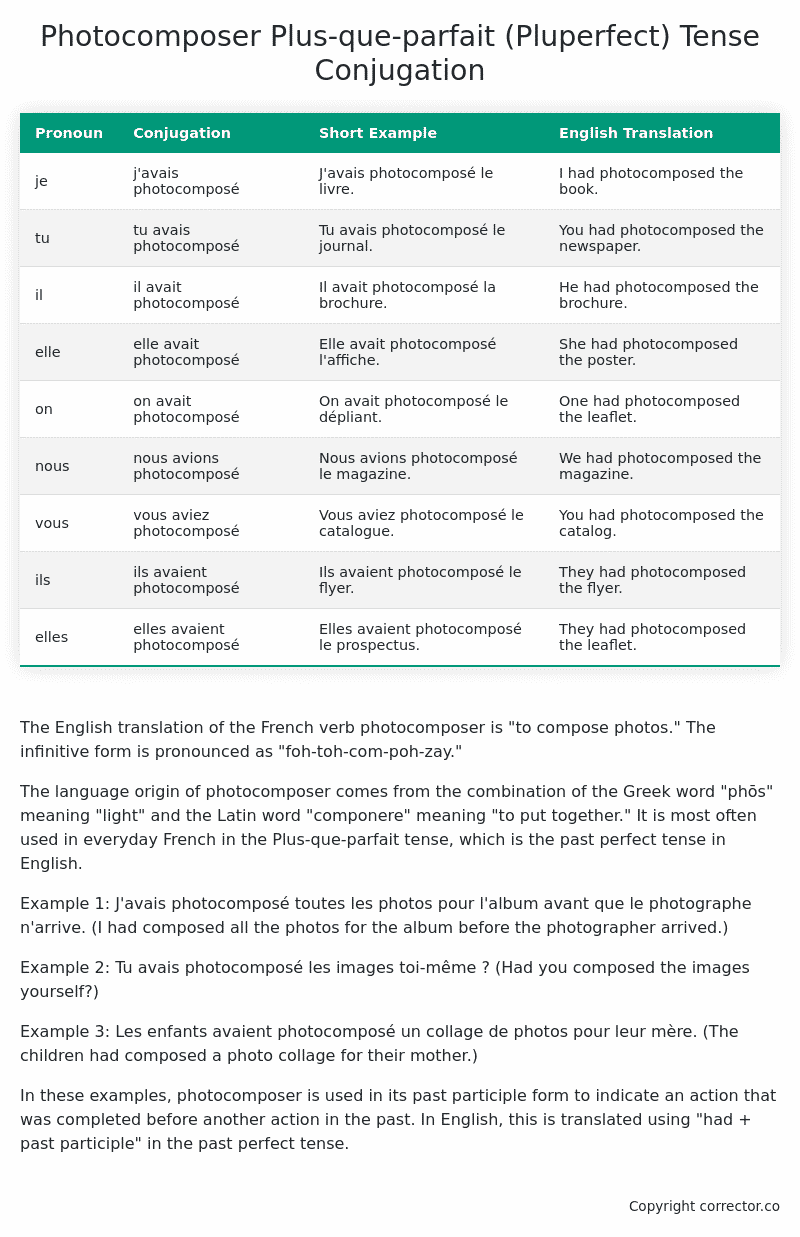Plus-que-parfait (Pluperfect) Tense Conjugation of the French Verb photocomposer
Introduction to the verb photocomposer
The English translation of the French verb photocomposer is “to compose photos.” The infinitive form is pronounced as “foh-toh-com-poh-zay.”
The language origin of photocomposer comes from the combination of the Greek word “phōs” meaning “light” and the Latin word “componere” meaning “to put together.” It is most often used in everyday French in the Plus-que-parfait tense, which is the past perfect tense in English.
Example 1: J’avais photocomposé toutes les photos pour l’album avant que le photographe n’arrive. (I had composed all the photos for the album before the photographer arrived.)
Example 2: Tu avais photocomposé les images toi-même ? (Had you composed the images yourself?)
Example 3: Les enfants avaient photocomposé un collage de photos pour leur mère. (The children had composed a photo collage for their mother.)
In these examples, photocomposer is used in its past participle form to indicate an action that was completed before another action in the past. In English, this is translated using “had + past participle” in the past perfect tense.
Table of the Plus-que-parfait (Pluperfect) Tense Conjugation of photocomposer
| Pronoun | Conjugation | Short Example | English Translation |
|---|---|---|---|
| je | j’avais photocomposé | J’avais photocomposé le livre. | I had photocomposed the book. |
| tu | tu avais photocomposé | Tu avais photocomposé le journal. | You had photocomposed the newspaper. |
| il | il avait photocomposé | Il avait photocomposé la brochure. | He had photocomposed the brochure. |
| elle | elle avait photocomposé | Elle avait photocomposé l’affiche. | She had photocomposed the poster. |
| on | on avait photocomposé | On avait photocomposé le dépliant. | One had photocomposed the leaflet. |
| nous | nous avions photocomposé | Nous avions photocomposé le magazine. | We had photocomposed the magazine. |
| vous | vous aviez photocomposé | Vous aviez photocomposé le catalogue. | You had photocomposed the catalog. |
| ils | ils avaient photocomposé | Ils avaient photocomposé le flyer. | They had photocomposed the flyer. |
| elles | elles avaient photocomposé | Elles avaient photocomposé le prospectus. | They had photocomposed the leaflet. |
Other Conjugations for Photocomposer.
Le Present (Present Tense) Conjugation of the French Verb photocomposer
Imparfait (Imperfect) Tense Conjugation of the French Verb photocomposer
Passé Simple (Simple Past) Tense Conjugation of the French Verb photocomposer
Passé Composé (Present Perfect) Tense Conjugation of the French Verb photocomposer
Futur Simple (Simple Future) Tense Conjugation of the French Verb photocomposer
Futur Proche (Near Future) Tense Conjugation of the French Verb photocomposer
Plus-que-parfait (Pluperfect) Tense Conjugation of the French Verb photocomposer (this article)
Passé Antérieur (Past Anterior) Tense Conjugation of the French Verb photocomposer
Futur Antérieur (Future Anterior) Tense Conjugation of the French Verb photocomposer
Subjonctif Présent (Subjunctive Present) Tense Conjugation of the French Verb photocomposer
Subjonctif Passé (Subjunctive Past) Tense Conjugation of the French Verb photocomposer
Subjonctif Imparfait (Subjunctive Imperfect) Tense Conjugation of the French Verb photocomposer
Conditionnel Présent (Conditional Present) Tense Conjugation of the French Verb photocomposer
Conditionnel Passé (Conditional Past) Tense Conjugation of the French Verb photocomposer
L’impératif Présent (Imperative Present) Tense Conjugation of the French Verb photocomposer
L’infinitif Présent (Infinitive Present) Tense Conjugation of the French Verb photocomposer
Struggling with French verbs or the language in general? Why not use our free French Grammar Checker – no registration required!
Get a FREE Download Study Sheet of this Conjugation 🔥
Simply right click the image below, click “save image” and get your free reference for the photocomposer Plus-que-parfait tense conjugation!

Photocomposer – About the French Plus-que-parfait (Pluperfect) Tense
Tense Formation
Common everyday usage patterns
Sequencing of past events
Background information
Hypothetical or reported speech
Interactions with other tenses
Summary
I hope you enjoyed this article on the verb photocomposer. Still in a learning mood? Check out another TOTALLY random French verb conjugation!


